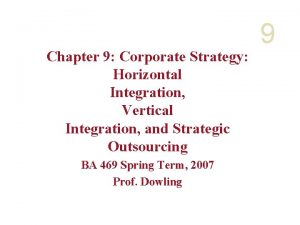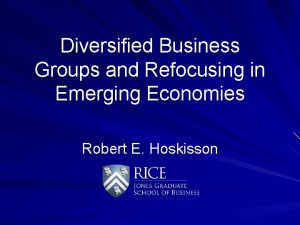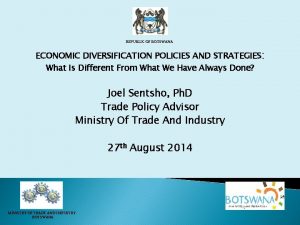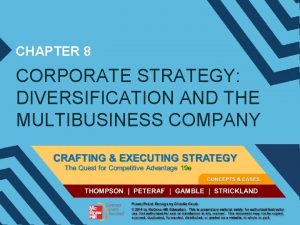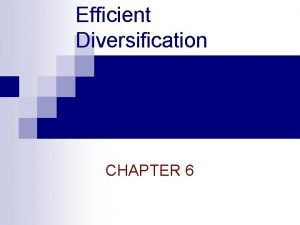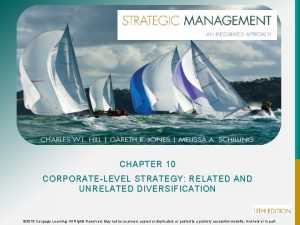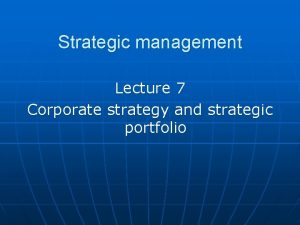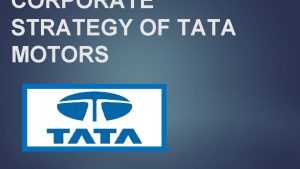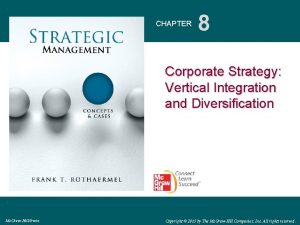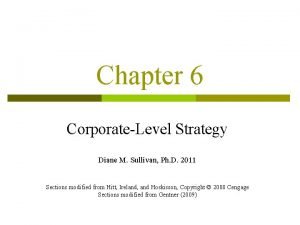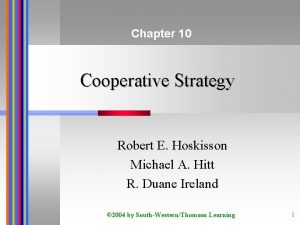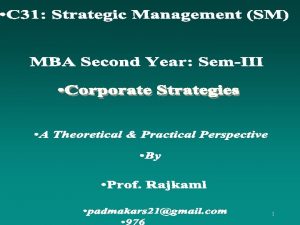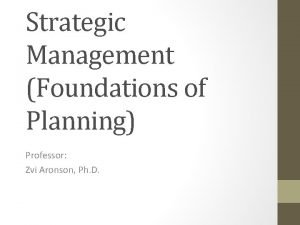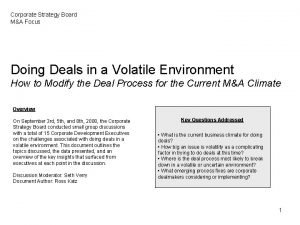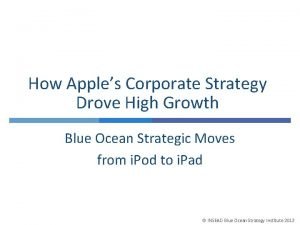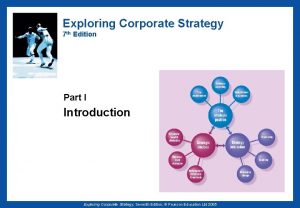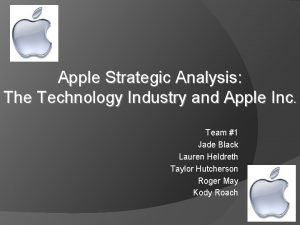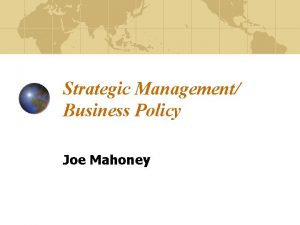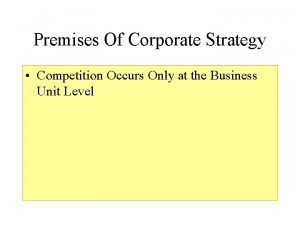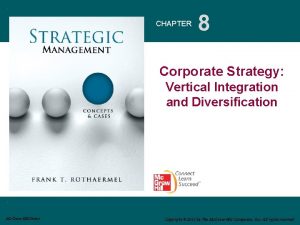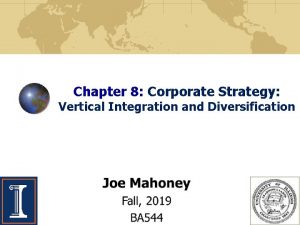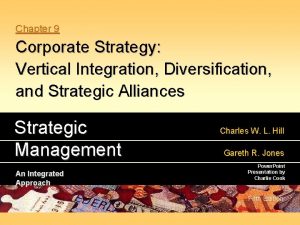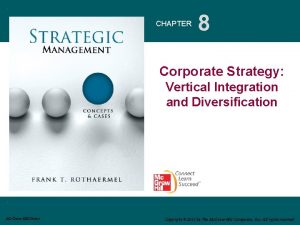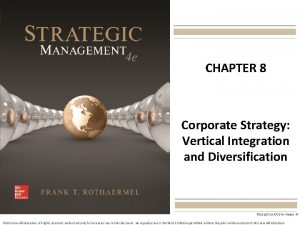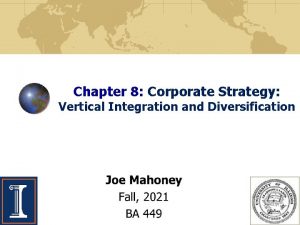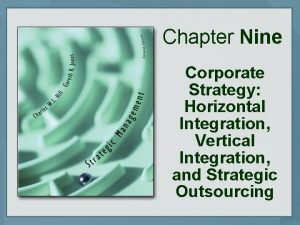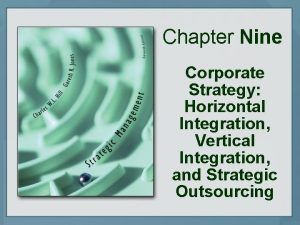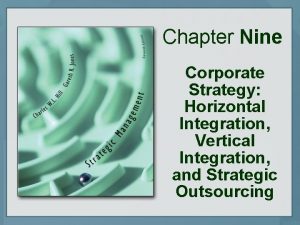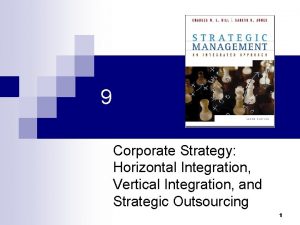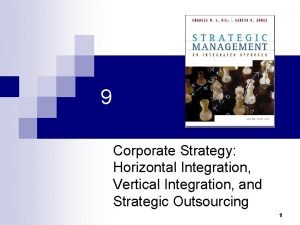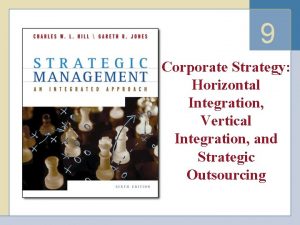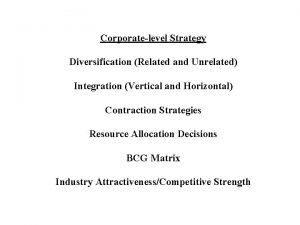Chapter 8 Corporate Strategy Vertical Integration and Diversification

















































- Slides: 49

Chapter 8: Corporate Strategy: Vertical Integration and Diversification

2 amazon. com • Originally was an online book seller – Started in a garage in a Seattle suburb • amazon now: – Sells 30 times the number of items sold by Wal-mart – A widely-diversified technology company – Holds 2/3 market share in e-books • Sells more e-books than print books – Streams music, movies, TV shows – Largest cloud computing service provider globally – Is establishing country-specific sites Copyright © 2017 by Mc. Graw-Hill Education. This is proprietary material solely for authorized instructor use. Not authorized for sale or distribution in any manner. This document may not be copied, scanned, duplicated, forwarded, distributed, or posted on a website, in whole or part.

3 amazon. com • amazon is engaged in a competitive battle. – For control of the emerging digital ecosystem – Competes with Apple, Google, Facebook, Walmart, Microsoft, and IBM • amazon is one of the five largest technology companies. – Annual sales = $100 billion – Struggles to obtain profitability • In 2014, it lost $250 million Copyright © 2017 by Mc. Graw-Hill Education. This is proprietary material solely for authorized instructor use. Not authorized for sale or distribution in any manner. This document may not be copied, scanned, duplicated, forwarded, distributed, or posted on a website, in whole or part.

4 amazon. com • amazon. com continues to diversify. – Is positioning to capture a piece of the $10 B college bookstore market • Goals and outcomes of “amazon campus” – – – To offer textbooks, clothing, food Offer prime membership at a discount Guarantees next-day delivery Estimated to save students $200 -$400 per year Binds a new generation of users early. Copyright © 2017 by Mc. Graw-Hill Education. This is proprietary material solely for authorized instructor use. Not authorized for sale or distribution in any manner. This document may not be copied, scanned, duplicated, forwarded, distributed, or posted on a website, in whole or part.

5 amazon. com • Amazon. com continues to spend billions on seemingly unrelated diversification efforts. Do you believe these efforts contribute to Amazon gaining and sustaining a competitive advantage. Why or why not? • Amazon is now over 20 years old and makes over $100 billion in annual revenues. As an investor, would it concern you that Amazon. com has yet to deliver on economic profits? Why or why not? • How much longer do you think investors will be patient with Jeff Bezos as he continues to pursue billion dollar diversification decisions? Copyright © 2017 by Mc. Graw-Hill Education. This is proprietary material solely for authorized instructor use. Not authorized for sale or distribution in any manner. This document may not be copied, scanned, duplicated, forwarded, distributed, or posted on a website, in whole or part.

6 What is Corporate Strategy? Copyright © 2017 by Mc. Graw-Hill Education. This is proprietary material solely for authorized instructor use. Not authorized for sale or distribution in any manner. This document may not be copied, scanned, duplicated, forwarded, distributed, or posted on a website, in whole or part.

What Is Corporate Strategy? • Corporate strategy Ø Corporate strategy is the way a company creates value through the configuration and coordination of its multi-market activities Ø Quest for competitive advantage when competing in multiple industries • Corporate strategy concerns the scope of the firm: Ø What stages of the industry value chain (vertical integration)? Ø What range of products and services (horizontal integration)? Ø What geographic markets (regional, national, and/or global) to compete in? 8– 7

Three Dimensions of Corporate Strategy Scope of the firm determines boundaries along these three dimensions. 8– 8

9 The Boundaries of the Firm Copyright © 2017 by Mc. Graw-Hill Education. This is proprietary material solely for authorized instructor use. Not authorized for sale or distribution in any manner. This document may not be copied, scanned, duplicated, forwarded, distributed, or posted on a website, in whole or part.


11 Transaction Cost Economies • Helps explain and predict boundaries of the firm • Helps managers decide – Which activities to perform in-house – Which services and products to obtain from the external market Copyright © 2017 by Mc. Graw-Hill Education. This is proprietary material solely for authorized instructor use. Not authorized for sale or distribution in any manner. This document may not be copied, scanned, duplicated, forwarded, distributed, or posted on a website, in whole or part. Exhibit 8. 2

12 Transaction Costs • Costs associated with an economic exchange • Can be within or external to a firm • External transaction costs – Searching for a firm individual to contract with – Negotiating, monitoring, and enforcing the contract • Internal transaction costs – – Recruiting and retaining employees Paying salaries and benefits Setting up a shop floor Providing office space and computers, etc. Copyright © 2017 by Mc. Graw-Hill Education. This is proprietary material solely for authorized instructor use. Not authorized for sale or distribution in any manner. This document may not be copied, scanned, duplicated, forwarded, distributed, or posted on a website, in whole or part.

Firms vs. Markets: Make or Buy? • Should a firm do things in-house (to make)? Or obtain externally (to buy)? • If Cin-house < Cmarket, then the firm should vertically integrate Ø Example: Google hires programmers to write code in-house rather than contracting out Ø Firms and markets have distinct advantages and disadvantages (see Exhibit 8. 3) 8– 13

14 Organizing Economic Activity: Firms vs. Markets Exhibit 8. 3 Copyright © 2017 by Mc. Graw-Hill Education. This is proprietary material solely for authorized instructor use. Not authorized for sale or distribution in any manner. This document may not be copied, scanned, duplicated, forwarded, distributed, or posted on a website, in whole or part.

15 Alternatives on the Make-or-buy Continuum Exhibit 8. 4 Copyright © 2017 by Mc. Graw-Hill Education. This is proprietary material solely for authorized instructor use. Not authorized for sale or distribution in any manner. This document may not be copied, scanned, duplicated, forwarded, distributed, or posted on a website, in whole or part.

8– 16

17 Is Coke Becoming a Monster? • The demand for Coke / Pepsi is falling. – Replaced by water & energy drinks • Coca Cola formed an alliance with Monster. – $2 B for a 16. 7% stake in the company • Why not an acquisition? – Several wrongful death suits – They can benefit from explosive growth. – They can protect their wholesome image and brand. – What is the strategic logic for why Coca-Cola took a minority investment in Monster? Copyright © 2017 by Mc. Graw-Hill Education. This is proprietary material solely for authorized instructor use. Not authorized for sale or distribution in any manner. This document may not be copied, scanned, duplicated, forwarded, distributed, or posted on a website, in whole or part.

18 Vertical Integration along the Industry Value Chain Copyright © 2017 by Mc. Graw-Hill Education. This is proprietary material solely for authorized instructor use. Not authorized for sale or distribution in any manner. This document may not be copied, scanned, duplicated, forwarded, distributed, or posted on a website, in whole or part.

19 A Vertical Value Chain The transformation of raw materials into finished goods and services along distinct vertical stages Exhibit 8. 5 Copyright © 2017 by Mc. Graw-Hill Education. This is proprietary material solely for authorized instructor use. Not authorized for sale or distribution in any manner. This document may not be copied, scanned, duplicated, forwarded, distributed, or posted on a website, in whole or part.

20 Forward and Backward Integration: The Smartphone Industry Exhibit 8. 6 Copyright © 2017 by Mc. Graw-Hill Education. This is proprietary material solely for authorized instructor use. Not authorized for sale or distribution in any manner. This document may not be copied, scanned, duplicated, forwarded, distributed, or posted on a website, in whole or part.

Back to the Future: Pepsi. Co’s Forward Integration • Pepsi. Co acquired bottlers in 2009 Ø Gain control over quality, pricing, distribution, and in-store display. Reversed a 1999 decision to sell off Pepsi bottlers v Goal now is faster innovative products launched v • Forward integration Ø Enhance flexibility and improve decision making Ø Cost saving and interdependence • Coca-Cola did the same: forward integration with bottlers 1– 21 8– 21

22 Benefits of Vertical Integration • Lowers costs • Improves quality • Facilitates scheduling and planning • Secures critical supplies and distribution channels • Facilitates investments in specialized assets Copyright © 2017 by Mc. Graw-Hill Education. This is proprietary material solely for authorized instructor use. Not authorized for sale or distribution in any manner. This document may not be copied, scanned, duplicated, forwarded, distributed, or posted on a website, in whole or part.

Benefits of Vertical Integration • Specialized assets Ø Assets that have significantly more value in their intended use than in their next best use • Types of specialized assets Ø Site specificity v Co-located such as coal plant and electric utility Ø Physical asset specificity v Bottling machinery Ø Human asset specificity v Mastering procedures of a particular organization 8– 23


Risks of Vertical Integration • Increasing costs Ø Internal suppliers lose incentives to compete • Reducing quality Ø Single captured customer can slow experience effects • Reducing flexibility Ø Slow to respond to changes in technology or demand • Increasing the potential for legal repercussions Ø FTC carefully reviewed Pepsi plans to buy bottlers 8– 25

26 Taper Integration • An alternative to vertical integration • Involves either: – Backward integration and relying on others for supplies – Forward integration and relying on others for distribution Exhibit 8. 7 Copyright © 2017 by Mc. Graw-Hill Education. This is proprietary material solely for authorized instructor use. Not authorized for sale or distribution in any manner. This document may not be copied, scanned, duplicated, forwarded, distributed, or posted on a website, in whole or part.

27 Strategic Outsourcing • Moving one or more internal value chain activities outside the firm’s boundaries to other firms in the industry value chain • Example: Off-shoring • Most active sectors of off-shoring: – Banking and financial services – Information Technology (IT) – Health Care Copyright © 2017 by Mc. Graw-Hill Education. This is proprietary material solely for authorized instructor use. Not authorized for sale or distribution in any manner. This document may not be copied, scanned, duplicated, forwarded, distributed, or posted on a website, in whole or part.

28 Corporate Diversification: Expanding Beyond a Single Market Copyright © 2017 by Mc. Graw-Hill Education. This is proprietary material solely for authorized instructor use. Not authorized for sale or distribution in any manner. This document may not be copied, scanned, duplicated, forwarded, distributed, or posted on a website, in whole or part.

Different Types of Corporate Diversification 8– 29

30 The Tata Group: Integration at the Corporate Level • A multinational conglomerate in Mumbai, India – Activities: tea, hospitality, steel, IT, communications, power, and automobiles • Tata Motors – Bought Jaguar and Range Rover from Ford (2008) – Created the Tata Nano a small, no-frills car • 50% cheaper than their next-lowest cost car – Pursues differentiation and low cost strategies simultaneously Copyright © 2017 by Mc. Graw-Hill Education. This is proprietary material solely for authorized instructor use. Not authorized for sale or distribution in any manner. This document may not be copied, scanned, duplicated, forwarded, distributed, or posted on a website, in whole or part.

31 The Tata Group: Integration at the Corporate Level • Tata Group’s corporate strategy aspires to integrate different strategic business units, each with its own profit and loss responsibilities. • Do you believe that Tata Group will be successful in implementing this corporate strategy? Why or why not? Copyright © 2017 by Mc. Graw-Hill Education. This is proprietary material solely for authorized instructor use. Not authorized for sale or distribution in any manner. This document may not be copied, scanned, duplicated, forwarded, distributed, or posted on a website, in whole or part.

Motivations For Diversification • Value Enhancing Motives: Ø Increase market power v Multi-point competition Ø R&D and new product development Ø Developing New Competencies (Stretching) Ø Transferring Core Competencies (Leveraging) v Utilizing excess capacity (e. g. , in distribution) v Economies of Scope v Leveraging Brand-Name (e. g. , Haagen-Dazs to chocolate candy) 8– 32

Leveraging Core Competencies for Corporate Diversification • Core competence Ø Unique skills and strengths Ø Allows firms to increase the value of product/service Ø Lowers the cost • Examples: v Wal-mart – global supply chain v Infosys – low-cost global delivery system • The core competence – market matrix Ø Provides guidance to executives on how to diversify in order to achieve continued growth 8– 33

34 Leveraging Core Competencies For Corporate Diversification Exhibit 8. 9 SOURCE: Adapted from G. Hamel and C. K. Prahalad (1994), Competing for the Future (Boston, MA: Harvard Business School Press). Copyright © 2017 by Mc. Graw-Hill Education. This is proprietary material solely for authorized instructor use. Not authorized for sale or distribution in any manner. This document may not be copied, scanned, duplicated, forwarded, distributed, or posted on a website, in whole or part.

Other Motivations For Diversification • Motivations that are “Value neutral”: Ø Diversification motivated by poor economic performance in current businesses. • Motivations that “Devaluate”: Ø Agency problem Ø Managerial capitalism (“empire building”) Ø Maximize management compensation Ø Sales Growth maximization v Professor William Baumol

Diversification • Issue #1: When there is a reduction in managerial (employment) risk, then there is upside and downside effects for stockholders: Ø On the upside, managers will be more willing to learn firm-specific skills that will improve the productivity and long-run success of the company (to the benefit of stockholders). Ø On the downside, top-level managers may have the economic incentive to diversify to a point that is detrimental to stockholders.

Diversification • Issue #2: There may be no economic value to stockholders in diversification moves since stockholders are free to diversify by holding a portfolio of stocks. No one has shown that investors pay a premium for diversified firms -in fact, discounts are common. Ø A classic example is Kaiser Industries that was dissolved as a holding company because its diversification apparently subtracted from its economic value. v Kaiser Industries main assets: (1) Kaiser Steel; (2) Kaiser Aluminum; and (3) Kaiser Cement were independent companies and the stock of each were publicly traded. Kaiser Industries was selling at a discount which vanished when Kaiser Industries revealed its plan to sell its holdings. 8– 37

38 Corporate Diversification and Firm Performance • Does corporate diversification lead to superior performance? – High and low levels of diversification = lower performance – Moderate levels of (related) diversification = higher firm performance Exhibit 8. 10 SOURCE: Adapted from L. E. Palich, L. B. Cardinal, and C. C. Miller (2000), “Curvilinearity in the diversification-performance linkage: An examination of over three decades of research, ” Strategic Management Journal 21: 155– 174. Copyright © 2017 by Mc. Graw-Hill Education. This is proprietary material solely for authorized instructor use. Not authorized for sale or distribution in any manner. This document may not be copied, scanned, duplicated, forwarded, distributed, or posted on a website, in whole or part.

39 Vertical Integration and Diversification: Sources of Value Creation and Costs Exhibit 8. 11 Copyright © 2017 by Mc. Graw-Hill Education. This is proprietary material solely for authorized instructor use. Not authorized for sale or distribution in any manner. This document may not be copied, scanned, duplicated, forwarded, distributed, or posted on a website, in whole or part.

40 Boston Consulting Group (BCG) Growth-share Matrix Copyright © 2017 by Mc. Graw-Hill Education. This is proprietary material solely for authorized instructor use. Not authorized for sale or distribution in any manner. This document may not be copied, scanned, duplicated, forwarded, distributed, or posted on a website, in whole or part. Exhibit 8. 12

Oracle Corporate Strategy: Combining Vertical Integration and Diversification 8– 41

42 Dynamic Corporate Strategy: Nike vs. Adidas Exhibit 8. 13 Copyright © 2017 by Mc. Graw-Hill Education. This is proprietary material solely for authorized instructor use. Not authorized for sale or distribution in any manner. This document may not be copied, scanned, duplicated, forwarded, distributed, or posted on a website, in whole or part.


Corporate Diversification • Internal capital markets Ø Source of value creation in a diversification strategy Ø Allows conglomerate to do a more efficient job of allocating capital • Coordination costs Ø A function of number, size, and types of businesses linked to one another • Influence costs Ø Political maneuvering by managers to influence capital and resource allocation • Bandwagon effects Ø Firms copying moves of industry rivals 8– 44



Sustainable Competitive Advantage • Trying to gain sustainable competitive advantage via mergers and acquisitions puts us right up against the “efficient market” wall: Ø If an industry is generally known to be highly profitable, there will be many firms bidding on the assets already in the market. Generally the discounted value of future cash flows will be impounded in the price that the acquirer pays. Thus, the acquirer is expected to make only a competitive rate of return on investment. 8– 47

Sustainable Competitive Advantage • And the situation may actually be worse, given the phenomenon of the winner’s curse. Ø The most optimistic bidder usually over- estimates the true value of the firm: v Quaker Oats, in late 1994, purchased Snapple Beverage Company for $1. 7 billion. Many analysts calculated that Quaker Oats paid about $1 billion too much for Snapple. In 1997, Quaker Oats sold Snapple for $300 million.

Sustainable Competitive Advantage • Under what scenarios can the bidder do well? Ø Luck Ø Asymmetric Information – This eliminates the competitive bidding premise implicit in the “efficient market hypothesis” Ø Specific-synergies (co-specialized assets) between the bidder and the target. – Once again, this eliminates the competitive bidding premise of the efficient market hypothesis.
 Business strategy vs corporate strategy
Business strategy vs corporate strategy Horizontal and vertical integration strategy
Horizontal and vertical integration strategy Parenting strategy in strategic management
Parenting strategy in strategic management Vertical integration
Vertical integration Samsung unrelated diversification strategy
Samsung unrelated diversification strategy Unrelated diversification companies
Unrelated diversification companies Economic diversification drive strategy botswana
Economic diversification drive strategy botswana Volkswagen diversification strategy
Volkswagen diversification strategy A strategy of diversifying into unrelated businesses
A strategy of diversifying into unrelated businesses Objectives of corporate finance
Objectives of corporate finance Efficient diversification
Efficient diversification Forward integration and backward integration
Forward integration and backward integration Simultaneous integration examples
Simultaneous integration examples Advantages of horizontal integration
Advantages of horizontal integration Vertical and horizontal integration worksheet
Vertical and horizontal integration worksheet Related and unrelated diversification
Related and unrelated diversification Intensive integrative and diversification growth strategies
Intensive integrative and diversification growth strategies Unrelated diversification companies
Unrelated diversification companies Intensive integrative and diversification growth strategies
Intensive integrative and diversification growth strategies Organizational strategy types
Organizational strategy types What is corporate strategy in strategic management
What is corporate strategy in strategic management Business vs corporate strategy
Business vs corporate strategy Corporate scope
Corporate scope Strategy map hr scorecard digital dashboard
Strategy map hr scorecard digital dashboard Dimensions of corporate strategy
Dimensions of corporate strategy Tata motors founded
Tata motors founded Corporate strategy triangle
Corporate strategy triangle A multidomestic corporate-level strategy is one in which:
A multidomestic corporate-level strategy is one in which: Corporate level cooperative strategy
Corporate level cooperative strategy Corporate level cooperative strategy
Corporate level cooperative strategy Corporate strategy
Corporate strategy Backward and forward integration
Backward and forward integration Business-level strategy
Business-level strategy Business-level strategy
Business-level strategy Cooperative strategy in strategic management
Cooperative strategy in strategic management Formulating corporate level strategy
Formulating corporate level strategy Types of corporate level strategy
Types of corporate level strategy Swot analysis in education example
Swot analysis in education example Corporate strategy board
Corporate strategy board Apple blue ocean strategy
Apple blue ocean strategy Three dimensions of corporate strategy
Three dimensions of corporate strategy Corporate financial strategy
Corporate financial strategy Nintendo bcg matrix
Nintendo bcg matrix Exploring corporate strategy 7th edition
Exploring corporate strategy 7th edition Apple corporate strategy analysis
Apple corporate strategy analysis Why strategic planning is important to all managers.
Why strategic planning is important to all managers. Strategic control
Strategic control A transnational corporate-level strategy seeks to achieve
A transnational corporate-level strategy seeks to achieve Market activated corporate strategy framework
Market activated corporate strategy framework Multipoint competition occurs when
Multipoint competition occurs when

